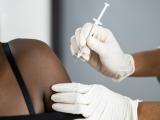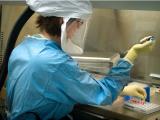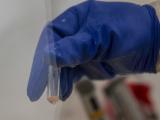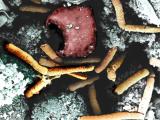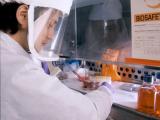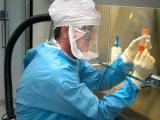Sep 14, 2007 (CIDRAP News) – Researchers from the University of Michigan recently reported promising results in animal tests of an inhaled anthrax vaccine, offering hope for a vaccine that would cause fewer side effects and be easier to store and administer than the licensed vaccine.
The vaccine contains a recombinant form of a Bacillus anthracis protein called protective antigen (rPA), combined with an adjuvant consisting of a "nanoemulsion" of water, soybean oil, alcohol, and a surfactant, according to the study. The report was published in the August issue of Infection and Immunity.
Tiny droplets of vaccine, 200 to 300 nanometers in size, pass through the nasal membranes to initiate a protective immune response, according to an Aug 15 press release from the University of Michigan. The researchers report that the vaccine induces both systemic and cellular immunity, as well as muscosal immunity in the nose and lungs.
The inhaled vaccine does not require refrigeration, the researchers say. Such a vaccine, if effective in humans, could be given along with antibiotics to people exposed in an anthrax attack, the University of Michigan statement said.
The US-licensed anthrax vaccine, Anthrax Vaccine Adsorbed (AVA), is a whole-microbe vaccine that has been in use since the 1950s and is given in six doses over 18 months, followed by annual boosters. It has spurred protests in the US military because of concerns about negative side effects; some troops have complained of chronic health problems triggered by the vaccine.
The researchers working on the inhaled anthrax vaccine say it requires two doses rather than six. They contend that the vaccine will be well tolerated, because the adjuvant contains only nontoxic ingredients.
"Anthrax spores can remain in the environment or even in the lungs of exposed individuals for some time," said Anna Bielinska, PhD, lead author of the study and a researcher at the Michigan Nanotechnology Institute for Medicine and Biological Sciences. "Nasal vaccination could be given to build up immunity after anthrax exposure and improve the outcome of other treatments."
The researchers immunized groups of mice with either one or two 20-microgram [mcg] doses of the intranasal vaccine (with the second dose 3 weeks after the first), and then monitored them for adverse reactions and antibody responses at 3- to 4-week intervals for up to 12 weeks. The vaccine doses contained 20 mcg of rPA mixed with a 0.1%, 0.5%, 1%, or 2% concentration of the nanoemulsion adjuvant in saline. Other groups of mice were given two doses of vaccines that included rPA and one of three other adjuvants, including aluminum hydroxide, or no adjuvant.
The investigators also vaccinated groups of guinea pigs with one or two doses of vaccine containing 10, 50, or 100 mcg of rPA, plus a 1% concentration of adjuvant in saline. Their antibody responses were measured at 3- to 4-week intervals for up to 22 weeks.
The vaccine induced both serum and bronchial antibody responses in mice after one or two doses, the report says. Antibody titers were lower in the 0.1% and 0.5% adjuvant groups, but there was no significant difference between the 1% and 2% formulations. When the researchers compared the different adjuvants, they found that titers were higher for the nanoemulsion group than for the other three adjuvants. No antibodies were detected in the group that received vaccine without adjuvant.
In both the mice and the guinea pigs, the vaccine also generated high levels of antibodies against lethal toxin, another key anthrax protein.
In challenge trials, conducted at biosafety level 3 and 4 labs in Ohio and Texas, groups of guinea pigs were vaccinated with 10-, 50-, and 100-mcg doses of rPA mixed with 1% nanoemulsion adjuvant. When the researchers injected the animals with a very high dose of anthrax spores, all the vaccinated guinea pigs survived, but the controls did not. Other guinea pigs were given high intranasal doses of anthrax; 40% to 70% of the immunized animals survived this challenge, but all the control animals died. The survival rate was similar to that seen with other anthrax vaccines, the investigators reported.
Though the researchers concluded that it is difficult to compare responses to various adjuvants and routes of administration, the nanoemulsion vaccine appeared to be at least as effective as others.
The duration of protection appears to be another advantage of the nanoemulsion vaccine, the researchers wrote. Guinea pigs that received the vaccine had immunoglobulin-G (IgG) responses after the first dose, and levels continued rising after a second dose at 4 weeks. Immunity lasted for at least 6 months.
Other researchers have encountered problems developing new anthrax vaccines. Last December the US Department of Health and Human Services (HHS) cancelled an $877.5 million Project Bioshield contract with VaxGen Inc, a Brisbane, Calif., company, after problems with potency delayed the start of clinical trials of its rPA vaccine.
The National Institutes of Health has been supporting anthrax vaccine research by Avecia, based in Manchester, England. The vaccine involves the same recombinant approach as VaxGen's candidate. A phase 2 trial is under way, and the company received a grant to develop a more stable version of the vaccine.
One of the next steps in testing the inhaled vaccine is to see if it can generate immunity in primates, the University of Michigan said. Safety studies in humans are in early planning stages, officials added.
Bielinska AU, Janczak KW, Landers JJ, et al. Mucosal immunization with a novel nanoemulsion-based recombinant anthrax protective antigen vaccine protects against Bacillus anthracis spore challenge. Infect Immun 2007 Aug;75(8):4020-29 [Abstract]
See also:
Aug 15 University of Michigan press release
http://www.eurekalert.org/pub_releases/2007-08/uomh-avp081507.php
May 30 CIDRAP News story "VaxGen stops work on anthrax vaccine, seeks partner"
CIDRAP anthrax overview
